Italian qualifying adjectives describe some quality of a noun.
Verde
Green
Felice
Happy

How and when do you use qualifying adjectives in Italian? In this lesson, you will find the answer to this question.
Let’s start with the explanation right away!
Table of Contents
How to use the Italian qualifying adjectives
As I said, Italian demonstrative adjectives are used to describe some quality of a noun, such as its color, its shape, or its emotional state.
Unlike English adjectives, Italian adjectives change number (singular, plural) and gender (masculine, feminine).
Italian adjectives match the gender and the number of the noun they describe.
That means that you can even have four different forms for a given adjective. Let’s take freddo, cold, as an example:
| Singular | Plural | |
| Masculine | Freddo | Freddi |
| Feminine | Fredda | Fredde |
For example, you can say…
Il caffè è freddo.
The coffee is cold.
(masculine singular)
Era un freddo mattino.
It was a cold morning.
(masculine singular)
Le mie mani sono fredde.
My hands are cold.
(feminine plural)
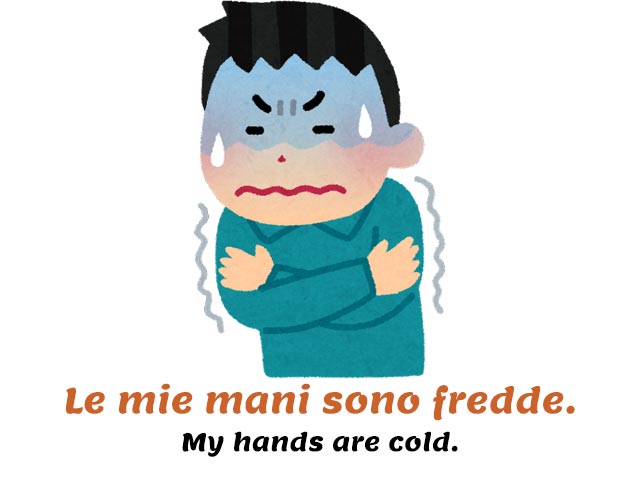
Luckily, not all qualifying adjectives in Italian have four different forms. Adjectives ending in -e have only two forms, one in the singular and one in the plural.
| Singular | Plural | |
| Masculine | Veloce | Veloci |
| Feminine | Veloce | Veloci |
| Singular | Plural | |
| Masculine | Triste | Tristi |
| Feminine | Triste | Tristi |
For example, you could say…
Il ghepardo è un animale veloce.
The cheetah is a fast animal.
(masculine singular)
Perché fate quelle facce tristi?
Why are you making those sad faces?
(feminine plural)
Adjectives ending in -a in the masculine form (such as -ista, -ita, and -cida) have three forms: one in the singular and two in the plural.
| Singular | Plural | |
| Masculine | Ottimista | Ottimisti |
| Feminine | Ottimista | Ottimiste |

Some colors have only one form.
Ho comprato un maglione rosa.
I bought a pink sweater.
(masculine singular)
Le tende sono viola.
The curtains are violet.
(feminine plural)
Perché il cielo è blu?
Why is the sky blue?
(masculine singular)
Masculine plural, feminine plural, both?
We have said that Italian qualifying adjectives match the number of the nouns they describe. What if we have two or more nouns?
If the nouns are all masculine, use the masculine plural form of the adjective.
Il cane e il lupo sono neri.
The dog and the wolf are black.
If the nouns are all feminine, use the feminine plural form of the adjective.
Le margherite e le rose sono belle.
Daisies and roses are beautiful.
If one noun is masculine and the other is feminine (mixed), use the masculine plural form of the adjective.
Il papà e la mamma sono sposati.
Dad and mom are married.
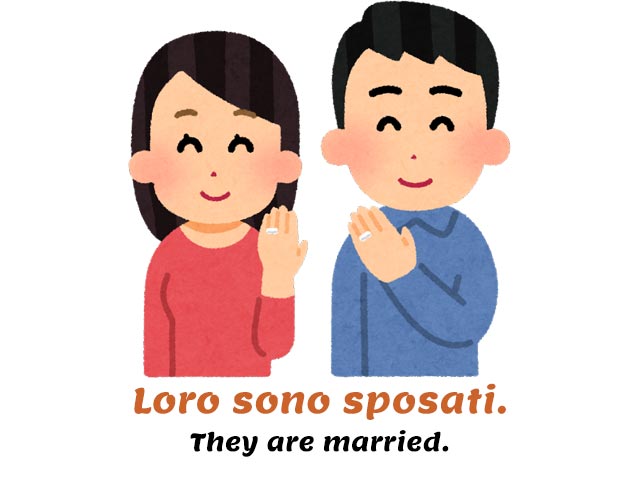
Where to place the Italian qualifying adjectives
Adjectives are more often placed in front of the noun they modify, but it’s also common to place them just before the noun.
Un rumore forte
A loud noise
Un forte rumore
A loud noise
However, the position of the adjective can slightly alter the meaning of the sentence.
Generally speaking, when adjectives are placed after the noun they are used to identify something. For example:
Butta via le riviste vecchie e metti in ordine quelle nuove.
Throw away the old magazines and arrange the new ones.
When the adjective is placed before the noun, it often just describes it:
Sono affezionato a queste vecchie riviste.
I am fond of these old magazines.
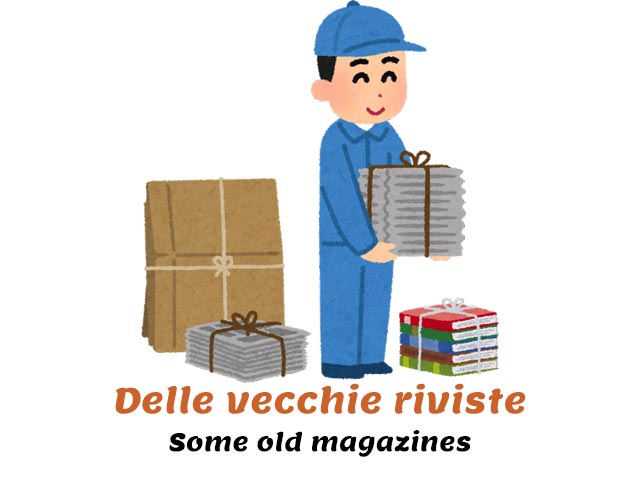
However, this is not a rule set in stone, so don’t worry too much about the position of the Italian qualifying adjectives. In the worst-case scenario, you will sound a bit off, but people will have no problems understanding you.
There are a few nouns and exceptions you have to watch out for, though.
Italian qualifying adjectives with fixed position
Adjectives are always placed after the noun in the presence of a preposition.
Un sorriso privo di gioia
A smile without “devoid of” joy
(NOT un privo sorriso di gioia)
Adjectives that describe a noun always go after that noun.
Una stanza rettangolare
A rectangular room
(NOT una rettangolare stanza)
Adjectives are always placed after the noun when they include a suffix.
Un gatto magrolino
A skinny cat
(NOT un magrolino gatto)
Adjectives of nationality always go after the noun.
Un bambino italiano
An Italian boy
(NOT un italiano bambino)
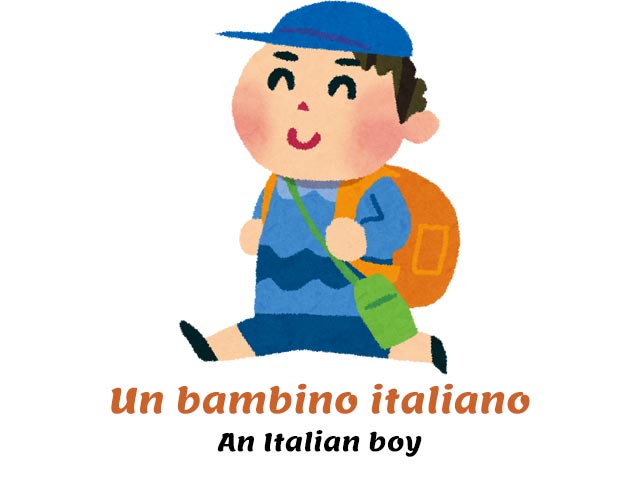
Vecchio amico… or amico vecchio?
Some Italian qualifying adjectives dramatically change meaning when used in common expressions, such as:
- vecchio amico
- pover’uomo
These are very different from amico vecchio and uomo povero.
Gandalf è un vecchio amico di Frodo.
Gandalf is an old friend of Frodo’s.
Amico vecchio is an elderly friend.
Pover’uomo. Non vorrei essere nei suoi panni.
Poor man. I wouldn’t want to be in his shoes.
Uomo povero is a man lacking money.
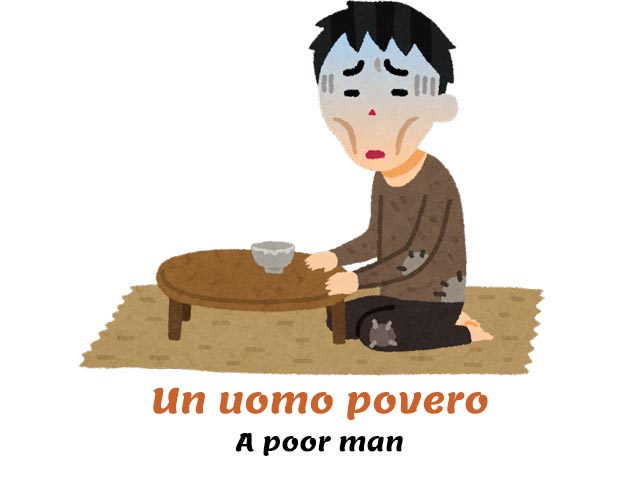
Degrees of Italian qualifying adjectives
Italian qualifying adjectives have three degrees: positive, comparative, and superlative.
What we have seen so far are examples of positive adjectives.
Il tavolo è rotto.
The table is broken.
How is the comparative degree formed?
How to form the comparative degree
The comparative degree is used to compare things. There are three kinds of comparative degrees for Italian qualifying adjectives.
The first kind is called comparativo di maggioranza (“comparative of majority”). It’s translated into English with more or with the suffix -er. In Italian, you add più, “more”, and the preposition di, “of”.
The correct order is più + adjective + di.
Andrea è più alto di Riccardo.
Andrea is taller than Riccardo.
The second kind is called comparativo di uguaglianza (“comparative of equality”). It’s translated into English with as. In Italian, you add come or quanto, “as, like”.
The correct order is come + adjective.
Andrea è alto come Riccardo.
Andrea is as tall as Riccardo.
Andrea è alto quanto Riccardo.
Andrea is as tall as Riccardo.
The third kind is called comparativo di minoranza (“comparative of minority”). It’s translated into English with less. In Italian, you add meno, “less”, and the preposition di, “of”.
The correct order is meno + adjective + di.
Andrea è meno alto di Riccardo.
Andrea is less tall than Riccardo.
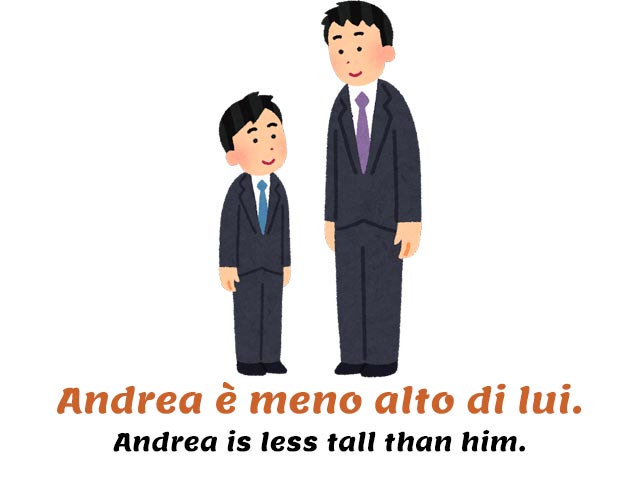
Better is translated as migliore or meglio, while worse is translated as peggiore or peggio. These are irregular superlatives. Remember that the article must match the gender of the noun!
Questa pizza è migliore della tua.
This pizza is better than yours.
Questo vino è peggiore di quello di ieri.
This wine is worse than that wine from yesterday.
How to form the superlative degree
The superlative degree is used to indicate the highest degree of a particular quality among a group of things. There are two kinds of superlative degrees for Italian qualifying adjectives.
The first kind is called superlativo relativo (“relative superlative”). It’s translated into English with most or least. In Italian, you add il più, “the most” or il meno (the least) and the preposition di, “of”.
The correct order is il più/meno + adjective + di.
Andrea è il più alto della classe.
Andrea is the tallest in the classroom.
The second kind is called superlativo assoluto (“absolute superlative”) and it’s used to indicate the highest degree of a particular quality in a general sense. It has no direct translation into English. You can translate it with adverbs such as “extremely” and “highly”.
It’s formed by adding the suffix -issimo to the adjective. Remember to remove the last vowel.
Andrea è altissimo.
Andrea is extremely tall.
Monica è bravissima a disegnare.
Monica is extremely good at drawing.
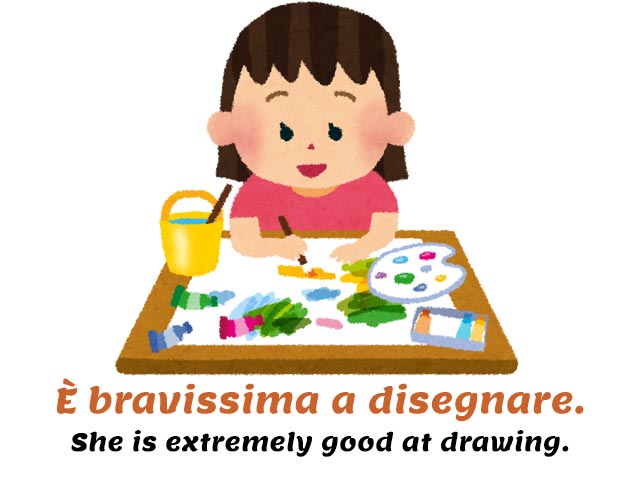
The best is translated as il migliore, while the worst is translated as il peggiore. These are irregular superlatives. Remember that the article must match the gender of the noun!
Questa pizza è la migliore.
This pizza is the best.
Questo vino è il peggiore che abbia mai bevuto.
This wine is the worst I have ever had.
More free Italian resources
You might want to keep learning Italian online with these free Italian resources:
❤️ If you liked this guide on the Italian qualifying adjectives, consider sharing it with your social media friends who are also studying Italian.


